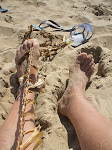 |
| 2007 willow and plastic lids |
Next year there will be some exhibitions of my work in Australia and in order to keep the shipping charges as low as possible we are not sending pieces with willow bark. They necessitate fumigation and all sorts of other noxious processes to avoid the immigration into Australia of rogue insects or diseases. But, the organisers of the exhibitions particularly liked a couple of the pieces in brown willow with plastic lids (see picture above) so I offered to try doing something similar but using white willow. I wasn't intending to reproduce the pieces, just to do something in the same vein. But, what I discovered was that my original choice of brown willow had been the best choice and that white willow didn't perform in the same way. It was much harder to prevent it kinking and the dark lines of the original brown willow looked better than the white. White might have worked on a dark surface but then there wouldn't be any of the graphic shadows and few galleries have dark walls and plinths. These problems were compounded by not having the right sort of wire, it was a bit too stiff and difficult to control and as I don't buy materials that was that. I remade the same things four times in different ways but it just didn't work. The lids, however, are still lovely and will be used for something else.
Fighting with my materials has never been my modus operandi, it always seems to show and the work looks as tense as I feel doing it. I want my work to look as though it has been effortless to make even though I might have spent many hours on it. It's an economically counterproductive way of working because if it looks effortless potential customers can't appreciate the work that has gone into it and therefore think the price I am asking is unjustified.
The balance between perceived and actual invested value, i.e time, is an interesting one. I was once approached by an American gallery who wanted me to make a 'basketry teapot' for a show they were putting on. It had to be teapot sized (cheap to ship) though it didn't need to function as one and with as much labour in it as possible to justify an expensive price tag. I didn't take up the invitation because not only did I find the idea of a basket teapot horrible, but, also because it seemed such a stupid idea to deliberately put as much labour as possible into a piece, when you could do something good much more simply.
Now I understand that there is a whole commercial craft market that operates out of galleries in high overhead locations that work on this principle. Because these galleries are often quite small they can't show big works but they can get a lot of financial value on plinths by showing small one-off works with phenomenal amounts of labour built into them. It's not the amount of labour I find difficult to deal with, but the fact that it exists for one purpose only, and that is to make the item more expensive. It's almost as if it doesn't seem to matter if the basketry teapot is a gross and pointless object as long as a customer can be convinced that they are buying a lot of someone elses skill, time and effort at a good price.
Ironically the production market works the other way. When we ran our own basket production company the buyers from stores constantly pushed us to lower our prices, but the only way we could do that was to take the labour out of the product. So for ten years I designed the labour out of our baskets and in the end our baskets had very little weaving left in them.
These experiences have brought me to a place where, although I believe Mies van der Rohes precept for minimalist design that "less is more", I find I still have to show some evidence of my labour in my work for people to like it enough to want to buy it. Its' a weird place to be in and quite challenging.
This week I am having fun with a sack full of corks, it may work, it may not, but at the moment I am optimistic that I will be able to strike the balance between evident effort and effortlessness!







